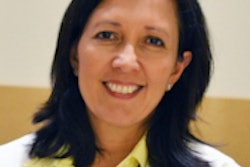CHICAGO - Breast cancer incidence is increasing worldwide, but screening mammography isn't always available. Could ultrasound serve as a primary test for breast cancer in countries without access to mammography? It's possible, according to research presented on Sunday at the RSNA meeting.
Dr. Wendie Berg, PhD, from the University of Pittsburgh, and colleagues used American College of Radiology Imaging Network (ACRIN) 6666 data to evaluate outcomes of breast cancer screening if ultrasound were the primary screening modality. The team investigated cancer detection, recall, and biopsy rates, as well as positive predictive value of biopsy.
Twenty-three percent of all breast cancers worldwide occur in women younger than 50, Berg said. In this population of women, breast tissue density is greater and, thus, mammography's performance can be compromised. Meanwhile, although ultrasound is not intended to be performed instead of mammography when mammography is available, it can help find node-negative invasive cancers -- the very cancers clinicians most want to find by screening, and which are unlikely to represent overdiagnosis, Berg said.
"The inspiration for this analysis actually came from the Avon Foundation, which holds an annual breast cancer forum to which it invites representatives from 40 different countries," Berg told session attendees. "At the forum I was asked: 'We don't have screening mammography in our country -- could we use breast ultrasound?' I thought this was an important question to consider, especially since ultrasound is portable, it can be less expensive than mammography, and there's no ionizing radiation and no compression."
The study gathered data from 2,662 participants across 21 sites in the U.S., Canada, and Argentina. The women completed three annual rounds of screening with mammography and whole-breast ultrasound (for a total of 7,473 exams), all of which were performed and interpreted by physicians. In the fourth year, each participant had either a biopsy or 12-month clinical follow-up.
The cohort included 110 women who were diagnosed with 111 breast cancer events, 80% of which were invasive. The total number of cancers detected by ultrasound or mammography was comparable, at 58 of 111 (53%) versus 59 of 111 (53%). Berg's group also found that the majority of the cancers detected by ultrasound were invasive (53 of 58, or 91%), compared with 41 of 59 (69%) by mammography.
Breast ultrasound did have some limitations, however. Out of 4,814 incidence screens (taken in years two and three), the modality had higher recall, short-term follow-up, and biopsy rates and lower PPV of biopsy compared to mammography:
- Recall rate: 10.7% for ultrasound versus 9.4% for mammography
- Short-term follow-up rate: 3.9% for ultrasound versus 1.6% for mammography
- Biopsy rate: 5.5% for ultrasound versus 2% for mammography
- PPV of biopsy: 12% for ultrasound versus 38% for mammography
The number of ultrasound screens needed to detect one cancer was comparable to mammography, at 129 compared to 127, respectively, Berg said.
"[Breast ultrasound's] false positive rates are greater than mammography's," Berg said. "The combination of mammography and breast ultrasound is better than either alone, but if mammography is unavailable, breast ultrasound is of benefit."
Session moderator Dr. Priscilla Jennings Slanetz, from Beth Israel Deaconess Medical Center, asked Berg how breast ultrasound could be incorporated into women's health in the developing world.
"There's a need for training, which we really haven't widely addressed even in the U.S.," Berg said. "And one of the great challenges around the world is a lack of radiologists, which means we need to train healthcare providers who don't necessarily have an imaging background. But the main thing to take away is that ultrasound is quite favorable in terms of what kinds of cancers it detects, even if the logistics for using it remain daunting."
The benefits of ABUS
Later in the session, Dr. Rachel Brem, of George Washington University Medical Center, and colleagues presented research on the benefits of using automated breast ultrasound (ABUS) in conjunction with mammography -- including finding early-stage, node-negative invasive cancer in women with dense breast tissue.
The study consisted of more than 15,000 asymptomatic women who had undergone no breast surgeries, interventional procedures, or cancer diagnoses and/or treatment in the previous 12 months. Brem's team found 112 cancers, 27% of which were detected only by ABUS (of these, 92% were invasive and 8% were ductal carcinoma in situ).
In addition, 44% of the cancers found only by automated breast ultrasound were grade 1, 44% were grade 2, and 14% were grade 3. Of the invasive cancers identified, 68% were stage IA, 5% were stage IB, 14% were stage IIA, 5% were stage IIB, and 9% were stage IIIA, Brem told session attendees.
"There's a clinical need for additional methods to screen women with dense breast tissue," she said. "ABUS was developed to harness the power of ultrasound to detect additional breast cancers and to be less operator-dependent [than handheld ultrasound]. In our study, ABUS found clinically significant cancers that would undoubtedly present as interval cancers, or at the next screening as larger or node-positive disease."
|
Study disclosures The study by Dr. Wendie Berg, PhD, and colleagues was funded by Avon Foundation and National Cancer Institute grants; she disclosed research and advisory associations with Gamma Medica-Ideas, Hologic, Naviscan, Koninklijke Philips Electronics NV, and SuperSonic Imagine. |




















